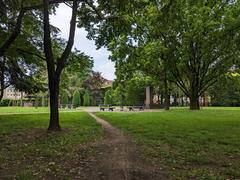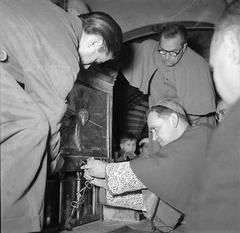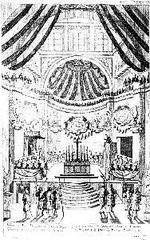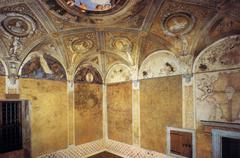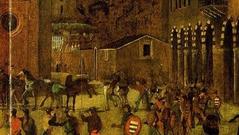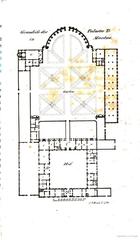
Rotonda di San Lorenzo: Visiting Hours, Tickets, and Historical Guide to Mantua’s Oldest Church
Date: 04/07/2025
Introduction
At the very heart of Mantua’s UNESCO-listed historic center lies the Rotonda di San Lorenzo, the city’s oldest surviving church and an outstanding monument of Romanesque architecture. Built in the late 11th century, the Rotonda’s unique circular plan, layered history, and evocative medieval frescoes make it a must-see for history enthusiasts, architecture lovers, and travelers seeking to immerse themselves in the spiritual and cultural heritage of Mantua (Comune di Mantova; in-lombardia.it).
This comprehensive guide details the Rotonda di San Lorenzo’s history, architectural features, visiting hours, ticketing, accessibility, and nearby attractions, ensuring you make the most of your visit to this remarkable Mantuan treasure.
Table of Contents
- Introduction
- Historical Context and Origins
- Architectural Features
- Visiting Information: Hours, Tickets, Accessibility, and Tours
- Cultural Significance and Restoration
- Urban Setting and Nearby Attractions
- Practical Travel Tips
- Frequently Asked Questions (FAQ)
- Conclusion
- References
Historical Context and Origins
The Rotonda di San Lorenzo was constructed around 1083, with tradition attributing its foundation to Matilda di Canossa, a major political and religious figure of the Middle Ages (Spotting History). Built atop the remnants of a Roman temple—possibly dedicated to Venus—the church’s foundation embodies the continuity of sacred space in Mantua (lombardiabeniculturali.it).
Throughout the Middle Ages, the Rotonda played a central spiritual and social role, connected to the city’s commercial and political ascendancy. The church’s dedication to Saint Lawrence, a revered Christian martyr, further elevated its religious importance. Over the centuries, Mantua’s changing rulers and urban transformations led to the Rotonda’s decline and eventual deconsecration in 1579. It fell into obscurity, engulfed by adjacent buildings, and remained hidden for centuries until its dramatic rediscovery in the early 20th century (MantovaUno; Wikipedia).
Architectural Features
Plan and Structure
The Rotonda’s most distinctive feature is its circular central plan, inspired by the Church of the Holy Sepulchre in Jerusalem—a rare choice in northern Italy at the time and a testament to the medieval desire to replicate sacred geography (in-lombardia.it). The structure measures approximately 16 meters in diameter and is built primarily of brick, in keeping with Lombard Romanesque tradition (lombardiabeniculturali.it).
The floor of the Rotonda is sunken about 1.5 meters below the current street level, a feature resulting from centuries of urban development that gradually raised the surrounding ground (artsandculture.google.com).
Columns, Ambulatory, and Matroneum
Inside, a double ring of columns—ten below and twelve above—supports a surrounding ambulatory and the matroneum, a gallery historically reserved for women (Spotting History). The columns themselves are a blend of Roman spolia and medieval masonry, underscoring the site’s layered history and the resourcefulness of its builders.
Frescoes and Artistic Heritage
The Rotonda was originally decorated with extensive frescoes. Surviving fragments from the 11th and 12th centuries, found in the matroneum and the apse, display the stylized forms and iconography typical of the Byzantine school. Later additions include a notable 15th-century fresco depicting the Martyrdom of Saint Lawrence (Finestre sull’Arte).
Visiting Information: Hours, Tickets, Accessibility, and Tours
Hours & Admission
-
Weekdays: 10:00–13:00 and 14:00–18:00
-
Weekends: 10:00–19:00
-
Hours may be subject to change on public holidays; always check the official Mantua tourism site or contact the church ahead of your visit.
-
Tickets: Admission is free; donations are welcomed to support ongoing conservation (Justin Plus Lauren).
Accessibility
- Entry is via a staircase with wide, low steps and two ramps. While there is no handrail, the ramps accommodate limited mobility visitors, though accompaniment is advisable for those needing additional support.
- A tactile panel with raised lettering and a floor plan is available for visually impaired visitors, and tactile flooring aids navigation inside (Mantova Sabbioneta UNESCO).
- APAM city buses serving the area are wheelchair-accessible and equipped with voice announcements (APAM Mobility Services).
Guided Tours
Guided tours can be arranged through local tour operators or the Mantua tourist office. These tours offer valuable insights into the Rotonda’s history, architecture, and restoration. English tours are available, and booking in advance is recommended, especially in peak tourist seasons (Finestre sull’Arte).
Cultural Significance and Restoration
The Rotonda di San Lorenzo’s layered history reflects Mantua’s own evolution. After deconsecration, the church served secular functions, including use as a warehouse and private residences. It was only in 1908, during urban redevelopment, that the Rotonda was rediscovered almost intact. Restoration efforts unveiled the medieval structure, preserved surviving frescoes, and reconstructed the dome. The church was reconsecrated in 1926 and is currently maintained by the Dominican Fraternity (MantovaUno; Wikipedia).
The Rotonda’s circular design echoes other Mantuan monuments, such as the round courtyard of Andrea Mantegna’s house, and its ongoing use for worship and special events underscores its enduring role in Mantua’s cultural identity.
Urban Setting and Nearby Attractions
Situated in lively Piazza delle Erbe, the Rotonda is surrounded by medieval and Renaissance landmarks:
- Palazzo della Ragione: Medieval civic building adjacent to the Rotonda.
- Basilica di Sant’Andrea: Renowned for housing the relic of the Blood of Christ.
- Palazzo Ducale: The historic seat of the Gonzaga family.
- Local cafes and shops: Enjoy Mantua’s culinary specialties and vibrant local life (The Italy Edit).
Practical Travel Tips
- Getting There: The Rotonda is a short walk from the Mantua train station and is easily reached by public transport.
- Best Time to Visit: Early mornings and late afternoons are quieter and offer the best light for photography.
- Dress Code: Modest attire is encouraged, as the church remains a place of worship.
- Duration: A typical visit lasts 15–30 minutes; longer if you join a guided tour.
- Facilities: No restrooms on site; facilities are available nearby in Piazza delle Erbe.
Frequently Asked Questions (FAQ)
Q: Are tickets required to enter the Rotonda di San Lorenzo?
A: No, entry is free. Donations are appreciated.
Q: What are the visiting hours?
A: Weekdays from 10:00–13:00 and 14:00–18:00; weekends 10:00–19:00.
Q: Is the Rotonda accessible for those with disabilities?
A: Ramps and tactile aids are provided, but some visitors may require assistance.
Q: Can I take photographs inside?
A: Non-flash photography is allowed, but use of tripods may be restricted.
Q: Are guided tours available?
A: Yes, guided tours can be arranged through local operators or the tourist office.
Conclusion
The Rotonda di San Lorenzo is a living testament to Mantua’s spiritual, architectural, and cultural journey over nearly a millennium. Its rare Romanesque circular plan, surviving frescoes, and central location make it a highlight for any visitor. Take time to absorb the serene atmosphere, admire the architectural ingenuity, and reflect on Mantua’s rich history.
Enhance your visit with a guided tour, explore nearby attractions, and use digital resources like the Audiala app for expert commentary and personalized travel tips. Stay connected with Mantua’s vibrant cultural offering by following official tourism channels and related social media.
References
- Comune di Mantova
- Spotting History
- in-lombardia.it
- lombardiabeniculturali.it
- MantovaUno
- Wikipedia
- artsandculture.google.com
- Finestre sull’Arte
- Justin Plus Lauren
- Travel Connect Experience
- Italyscapes
- Mantova Sabbioneta UNESCO
- APAM Mobility Services
- The Italy Edit




